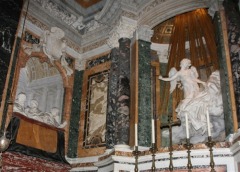Cappella Cornaro

1647-52
Marble, stucco, gilt bronze
Cappella Cornaro, Santa Maria della Vittoria, Rome
Image source: Web Gallery of Art
Though it is impossible to deny the genius and perfection of Bernini's work within St. Peter's Basilica, in order to see his self-expression as an artist one has to move away from the Vatican.
After the death of Urban VIII, Bernini was temporarily disgraced due to his failure concerning bell towers at St. Peter's. The new Pope, Innocent X, gave Bernini no major commissions and did not even ask him to submit suggestions. It was during this period that Cardinal Federigo Cornaro asked Bernini to design his family chapel at Santa Maria della Vittoria.
It was no secret that Bernini believed the chapel to be the finest work he ever produced. At its center is the superb sculpture, Ecstasy of St. Teresa, set into a deep niche over the high alter. This sculpture tells the story from St. Teresa's autobiography about an angel that plunged a golden spear into her breast, symbolizing Divine Love. When the spear was withdrawn she was "utterly consumed by the love of God." In his representation of the mystical event, St. Teresa rests laid back on a cloud, her limbs limp, her head tossed back, her lips parted in a moan, and her feet bare, an allusion to her order, members of which often went barefoot. As he frequently does in his sculptures, the event is frozen at its climax, with the angel about to throw his spear into Teresa's chest. Bernini masterfully succeeds in capturing the union mistica described by Teresa between God and herself, an ecstatic state attained by prayer.
Originally the chapel was illuminated by natural light. A boxlike extension of the transept projected through the exterior of the church to contain the niche, and a series of baffles funneled light into an oval oculus above the sculpture. Gilded rods that give the appearance of sunbeams fixed to the rim of the oculus reflected the light and gave it a sense of otherworldliness that added to the essence of the scene.
In the ceiling vault Bernini created a pained illusion of the real architecture with stuccoes. The stuccoes contained the lights and shadows of clouds with lively putti. In the center there is a golden light extending from a round source, and within this source is the dove of the Holy Ghost.
Along the sides of both walls of the chapel, in two boxes that are much like theater boxes, eight members of the Cornaro family are featured. The lively statues (though they are not the whole person, they can hardly be referred to as busts) depict the men arguing, reading, and pondering, probably about what they know is happening in the niche, since it becomes apparent when standing on the central axis opposite the group of St. Teresa that the members of the Cornaro family cannot actually see the event.
The family tomb chamber is under the chapel, and on the vault cover are two inlaid skeletons that have expressions of surprise, as shown in their lively gestures. These skeletons make the floor, not just the ceiling and walls, part of the dynamic unit.
Though the use of precious building materials was traditional in chapels, especially those dedicated to saints, the materials in the Cornaro Chapel are extremely lavish. The chapel contains columns of breccia africano, plaques of pavonazetto, verde antico, giallo antico, panels of alabaster and strips of breccia semesanto, some of the most handsome and exquisitely veined marbles that Rome would ever see, and it is fitting that Bernini's favorite and greatest work would contain such incredible materials.




